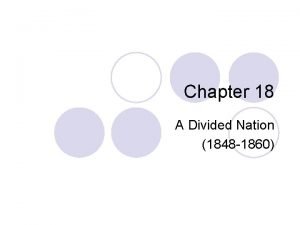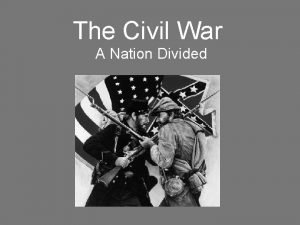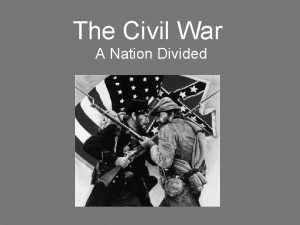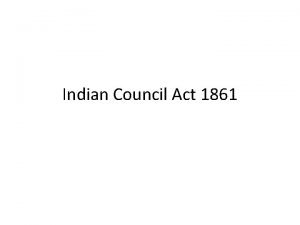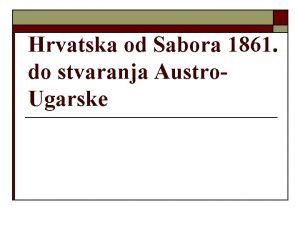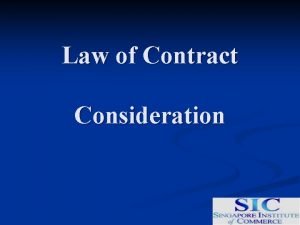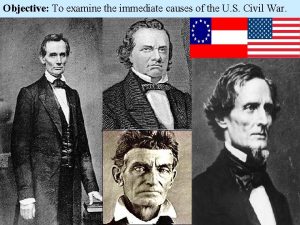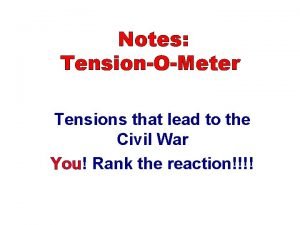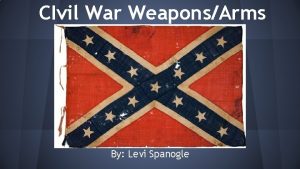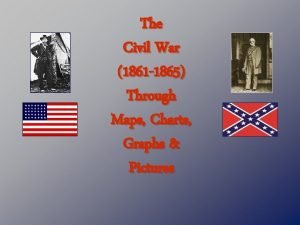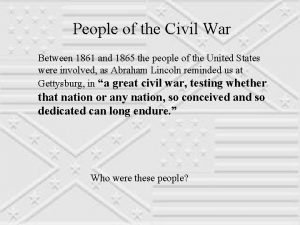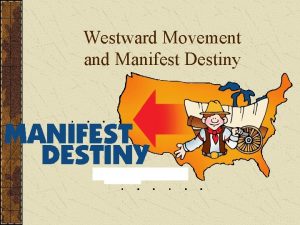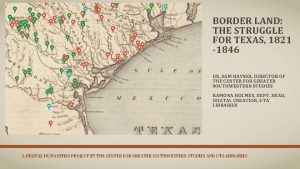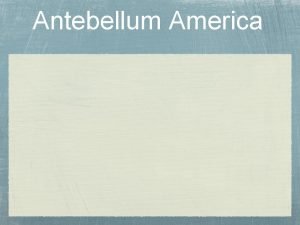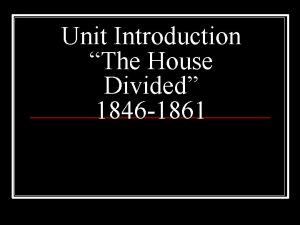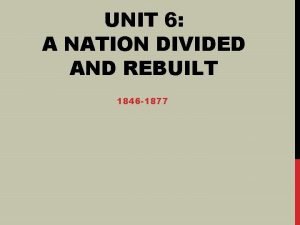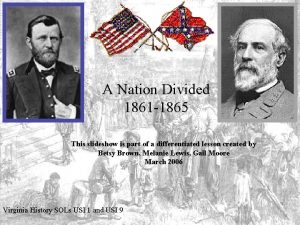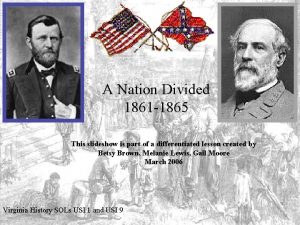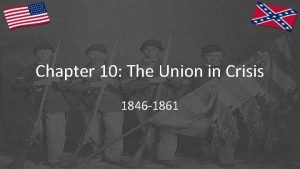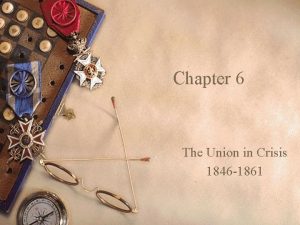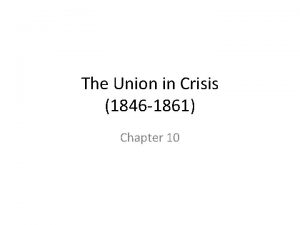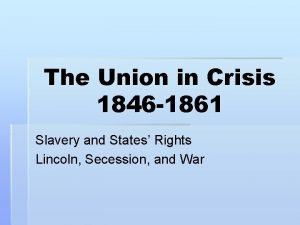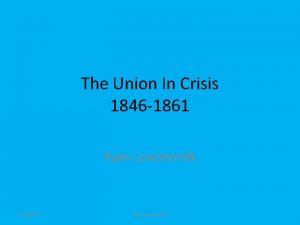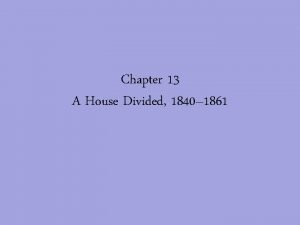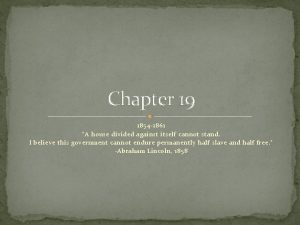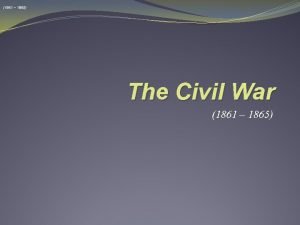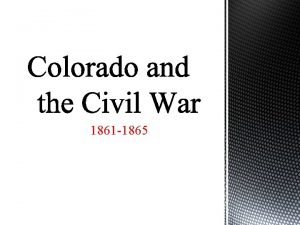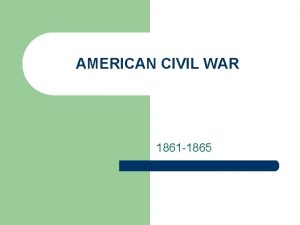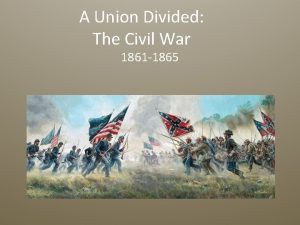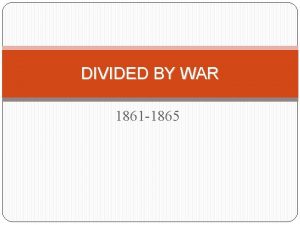Chapter 14 The Nation Divided 1846 1861 Essential













































- Slides: 45

Chapter 14: The Nation Divided 1846 - 1861 Essential Question: How did the nation try to deal with differences between the North and the South, but yet still fail?

TEKS 8 C: Calculate percent composition and empirical and molecular formulas. Terms and People • fugitives – enslaved people who have run away • Harriet Beecher Stowe –author of Uncle Tom’s Cabin • propaganda – false or misleading information that is spread to further a cause • Stephen Douglas –pushed the Kansas-Nebraska Act • John Brown – antislavery settler who led an attack on a proslavery settlement • civil war – a war between opposing groups of the same country

TEKS 8 C: Calculate percent composition and empirical and molecular formulas. How did the question of admission of new states to the Union fuel the debate over slavery and states’ rights? The Missouri Compromise of 1820 temporarily quieted the differences between the North and South. However, new territory added as a result of America’s victory in the Mexican-American War renewed the conflict.

TEKS 8 C: Calculate percent composition and empirical and molecular formulas. From 1820 to 1848, the balance of power between North and South held: 15 free states and 15 slave states. The tie was in danger of breaking because of new territory gained in the Mexican-American War.

TEKS 8 C: Calculate percent composition and empirical and molecular formulas. Even before the Mexican-American War had ended, politicians argued over what to do. The Wilmot Proviso Representative David Wilmot from Pennsylvania proposed a ban on slavery in all Mexican Cession territories. The bill passed in the House but not in the Senate. Still, it angered Southerners, who viewed the bill as an attack on slavery by the North.

TEKS 8 C: Calculate percent composition and empirical and molecular formulas. Northerners were upset as well. In the 1848 election, many Democrats and Whigs were disappointed with their party’s stand on slavery. Antislavery Democrats and Whigs formed a new political party. Free-Soil Party The party called for the territory from the Mexican. American War to be “free soil. ” The Free-Soil Party chose Martin Van Buren as its candidate.

TEKS 8 C: Calculate percent composition and empirical and molecular formulas. Democratic candidate Lewis Cass of Michigan suggested a solution that he hoped everyone would like. popular sovereignty He wanted to let the people in each state or territory decide whether to allow slavery.

TEKS 8 C: Calculate percent composition and empirical and molecular formulas. Presidential Election of 1848 Party Candidate Policy Democratic Party Senator Lewis Cass popular sovereignty Free-Soil Party Martin Van Buren slavery banned Whig Party General Zachary Taylor no stated policy although, North worries that Whigs are typically on the side of the South, so he might favor slavery. The Free-Soil Party took votes away from Senator Cass. This helped Zachary Taylor win the election (12 th president).

TEKS 8 C: Calculate percent composition and empirical and molecular formulas. Because of President Taylor’s lack of a policy concerning slavery, the tension between the North and South only increased. The two sides next clashed over California. Northerners argued that California should be a free state because most of its territory lay north of the Missouri Compromise. Southerners feared losing power. They threatened to secede from the nation if California was made a free state.

TEKS 8 C: Calculate percent composition and empirical and molecular formulas. North and South also disagreed over other issues related to slavery. Northerners wanted the slave trade abolished in Washington, D. C. Southerners called for a law that would force the return of fugitives. Months passed, and no solution was reached.

TEKS 8 C: Calculate percent composition and empirical and molecular formulas. In 1850, Senator Henry Clay of Kentucky made a series of proposals to resolve this conflict. The Senate’s discussion of Clay’s proposals produced one of the greatest debates in American history. If California enters the Union as a free state, then free states would gain a majority in Congress so Southerners wouldn’t be able to pass anti-slave laws.

TEKS 8 C: Calculate percent composition and empirical and molecular formulas. John C. Calhoun spoke against the compromise, and Daniel Webster spoke for it. Sectionalism John C. Calhoun Daniel Webster The United States needed to amend the Constitution. Otherwise, the South should secede. The United States should end sectionalism and adopt the compromise.

TEKS 8 C: Calculate percent composition and empirical and molecular formulas. With the territories acquired by the Mexican. American war, the nation could no longer overlook the slavery issue. Bitter debate was continuing to divide the nation. At first, Clay’s compromise of 1820 seemed to work for both sides. However, the compromise soon fell apart.

TEKS 8 C: Calculate percent composition and empirical and molecular formulas. Congress passed the Compromise of 1850, a series of laws meant to solve the controversy over slavery. Millard Fillmore is the president at the time (13 th President) The bitterness between the North and South caused all attempts at compromise to fail.

TEKS 8 C: Calculate percent composition and empirical and molecular formulas. The Compromise of 1850 included five laws that addressed issues related to slavery

TEKS 8 C: Calculate percent composition and empirical and molecular formulas. President Fillmore signed the compromise into law. Some of the new laws pleased the North, and others pleased the South. To Please the North • California admitted to the Union as a free state • Slave trade banned in Washington, D. C. To Please the South • Popular sovereignty used to decide slavery in the rest of the Mexican Cession • Tough new fugitive slave law

TEKS 8 C: Calculate percent composition and empirical and molecular formulas. The Fugitive Slave Act of 1850 allowed officials to arrest anyone accused of being a runaway slave. Suspects had no rights to a trial. Northern citizens were required to help capture accused runaways.

TEKS 8 C: Calculate percent composition and empirical and molecular formulas. Slave catchers would seize fugitives even after many years had passed since their escape. An Indiana man was separated from his wife and children when a slave owner claimed he had escaped 19 years prior. A wealthy tailor was seized, but his friends in New York quickly raised money to free him.

TEKS 8 C: Calculate percent composition and empirical and molecular formulas. The Fugitive Slave Act was the most controversial part of the Compromise of 1850. Senator Calhoun hoped that it would force northerners to admit that slaveholders had rights to their property. Instead, it convinced more northerners that slavery was evil. Northerners began to resist the law and help African Americans in the North escape to Canada.

TEKS 8 C: Calculate percent composition and empirical and molecular formulas. Harriet Beecher Stowe, the daughter of an abolitionist minister, was deeply affected by the Fugitive Slave Law. In 1853, Stowe published the novel Uncle Tom’s Cabin, about an enslaved man who is abused by his cruel owner.

TEKS 8 C: Calculate percent composition and empirical and molecular formulas. Stowe’s novel provoked strong reactions from people on both sides of the slavery issue. Many northerners were shocked and began to view slavery as a serious moral problem rather than a political issue. Many white southerners said Uncle Tom’s Cabin was propaganda, misleading information meant to further a cause.

TEKS 8 C: Calculate percent composition and empirical and molecular formulas. The debate over slavery continued with the Kansas and Nebraska territories. Southerners refused to admit the territories because they lay above the Missouri Compromise line. In 1854, Senator Stephen Douglas helped pass the Kansas-Nebraska Act. The Kansas. Nebraska Act Allowed the people in the territories to decide the slavery issue by popular sovereignty.

TEKS 8 C: Calculate percent composition and empirical and molecular formulas. North and South were divided over the Kansas. Nebraska Act as it reopened the issue of slavery in territories. Southerners supported the act. Northerners were outraged. They hoped the new territories would become slave states. They felt Douglas had betrayed them into allowing more slave states. Nevertheless, the act was signed into law by President Franklin Pierce (14 th president)

TEKS 8 C: Calculate percent composition and empirical and molecular formulas. Violence broke out. Bands of fighters began roaming the territory, terrorizing those who did not support their views. The violence in Kansas, as a result of the Kansas Nebraska Act, was so bad that it earned Kansas the name Bleeding Kansas.

TEKS 8 C: Calculate percent composition and empirical and molecular formulas. The violence in Kansas spread over into the United States Senate. Abolitionist Charles Sumner spoke out against proslavery Senator Andrew Butler’s nephew beat Sumner unconscious in the Senate chamber. By 1856, all attempts at compromise had failed.

TEKS 8 C: Calculate percent composition and empirical and molecular formulas. In the late 1850 s, new political parties, political debates, and court decisions highlighted the nation’s clashing views on slavery. These events caused growing tension between the North and South.

TEKS 8 C: Calculate percent composition and empirical and molecular formulas. Because of growing tensions, in 1854, the Whig Party split apart. Many northern Whigs formed a new party: the Republican Party. The Republican Party’s main goal was to stop the spread of slavery into the western territories.

TEKS 8 C: Calculate percent composition and empirical and molecular formulas. The Republicans quickly became a powerful force in politics. A Republican first ran for President in 1856. Republican John C. Frémont Democrat James Buchanan won (15 th president), but Frémont carried 11 of the nation’s free states.

TEKS 8 C: Calculate percent composition and empirical and molecular formulas. Soon after Buchanan took office, the U. S. Supreme Court made a landmark decision. In 1857, a slave named Dred Scott sued for his freedom. Scott had lived with his owner in two places where slavery was illegal. He argued that this meant he was a free man.

TEKS 8 C: Calculate percent composition and empirical and molecular formulas. Chief Justice Roger B. Taney wrote the decision in the Scott case. Dred Scott Decision • Scott could not sue because he was a slave and, therefore, not a U. S. citizen. • Living in a free state did not make Scott free. • Slaves are property and property rights are protected by the U. S. Constitution.

TEKS 8 C: Calculate percent composition and empirical and molecular formulas. Justice Taney also ruled that Congress did not have the power to prohibit slavery in any territory therefore, the Missouri Compromise was unconstitutional. Both northerners and southerners were shocked by the court’s decision. Southerners rejoiced because slavery was now legal in all territories. Northerners were shocked and had hoped slavery would die out. They now feared it would spread throughout the West.

TEKS 8 C: Calculate percent composition and empirical and molecular formulas. Many leaders spoke out against the ruling. • Frederick Douglass hoped the outrage against the decision would fuel the abolition movement. • Abraham Lincoln, an Illinois lawyer, argued against the idea that African Americans could not be citizens.

TEKS 8 C: Calculate percent composition and empirical and molecular formulas. Lincoln had served one term in Congress but had returned to practicing law. In 1858, Lincoln ran for Senate against Stephen Douglas, an incumbent Illinois senator. Now, his opposition to the Kansas. Nebraska Act (write down 2 x) drew him back to the world of politics. He joined the Republican party.

TEKS 8 C: Calculate percent andengaged empirical and molecular formulas. Lincoln andcomposition Douglas in a series of debates, which were followed throughout the country. Douglas’s view Lincoln’s view • On popular sovereignty: Individual states should decide whether or not to continue the practice of slavery. • Stand on slavery: Slavery is wrong and it should not spread to the western territories and it will die out on its own a. Lincoln wants equality for African Americans. b. African Americans are entitled to the rights of life, liberty, and the pursuit of happiness. Lincoln said that the United States could not survive as a half slave, half free country. He favored the Union to end slavery.

TEKS 8 C: Calculate percent composition and empirical and molecular formulas. Douglas won the Senate election. • However, the debates helped Lincoln become a national figure. • Two years later, the two men would be rivals for the presidency.

TEKS 8 C: Calculate percent composition and empirical and molecular formulas. In total, four candidates ran for president in 1860 because there were pro-slave and anti-slave factions of the Democratic Party and chose different candidates. The South joined the Contitutional Union Party. Republicans Abraham Lincoln criticized slavery Northern Democrats Stephen Douglas favored individual states deciding on slavery Southern Democrats John Breckinridge supported slavery in the territories Constitutional Union Party John Bell promised to protect slavery and keep nation together

TEKS 8 C: Calculate percent composition and empirical and molecular formulas. The outcome of the election showed just how fragmented the nation had become: Lincoln won in every free state. Breckinridge won most of the slave states. Bell won three states in the upper South. Douglas won Missouri.

TEKS 8 C: Calculate percent composition and empirical and molecular formulas. Abraham Lincoln received enough electoral votes to win the election becoming the 16 th president of the United States. This election showed how divided the nation was becoming.

TEKS 8 C: Calculate percent composition and empirical and molecular formulas. Southerners felt that the President and Congress were now set against their interests—especially slavery. Some of the most powerful southern leaders believed that they were out of options. When South Carolina found out Lincoln won the election they decided to secede from the Union.

TEKS 8 C: Calculate percent composition and empirical and molecular formulas. Frustrated southern states formed the Confederate States of America. Six other southern states soon followed : Texas, Louisiana, Mississippi, Alabama, Georgia, and Florida

TEKS 8 C: Calculate percent composition and empirical and molecular formulas. Some moderate southerners did not want to secede, but their voices were overwhelmed. Andrew Johnson and Sam Houston were among those against succession. By March, the Confederacy had adopted a constitution. Former Senator Jefferson Davis was named president of the Confederate States of America.

TEKS 8 C: Calculate percent composition and empirical and molecular formulas. When President Lincoln was inaugurated on March 4, 1861, the nation faced the greatest crisis in its history. Lincoln told the seceded states he would not “interfere… with slavery where it exists. ” Lincoln encouraged the Confederacy to return to the union. The Confederate states rejected this message by taking over federal property within their borders

TEKS 8 C: Calculate percent composition and empirical and molecular formulas. Already, an urgent struggle had begun. The commander at Fort Sumter, South Carolina, had refused to surrender to the Confederates. The Confederates tried to starve the troops into surrendering. Lincoln did not send troops because he did not want other states to secede. He planned to send food on ships without guns.

TEKS 8 C: Calculate percent composition and empirical and molecular formulas. On April 12, 1861, Confederate forces attacked Fort Sumter. The U. S. troops surrendered. The Confederate attack on Fort Sumter marked the beginning of a long civil war.

TEKS 8 C: Calculate percent composition and empirical and molecular formulas. By 1861, many people in the North and South believed that war was unavoidable. Civil War However, Americans were unprepared for the terrible war that would last for the next four years.
 Chapter 22 section 3 a nation divided
Chapter 22 section 3 a nation divided A divided nation section 1
A divided nation section 1 A nation divided: north vs. south
A nation divided: north vs. south Divided nation quote
Divided nation quote What does this picture depict
What does this picture depict Nation state vs nation
Nation state vs nation Nation state vs nation
Nation state vs nation Nation vs nation state
Nation vs nation state Indian councils act of 1861
Indian councils act of 1861 Unionistička stranka 1861
Unionistička stranka 1861 Bolton vs madden
Bolton vs madden John brown poster
John brown poster Tensionometer
Tensionometer Springfield model 1861 rifle facts
Springfield model 1861 rifle facts Civil war 1861/1862
Civil war 1861/1862 Civil war 1861/1862
Civil war 1861/1862 Plamatic acid
Plamatic acid The oregon treaty of 1846
The oregon treaty of 1846 Remembrance emily bronte poem
Remembrance emily bronte poem En1846
En1846 Din 1846
Din 1846 1846
1846 In 1846 congressman david wilmot proposed to
In 1846 congressman david wilmot proposed to Hát kết hợp bộ gõ cơ thể
Hát kết hợp bộ gõ cơ thể Slidetodoc
Slidetodoc Bổ thể
Bổ thể Tỉ lệ cơ thể trẻ em
Tỉ lệ cơ thể trẻ em Gấu đi như thế nào
Gấu đi như thế nào Tư thế worms-breton
Tư thế worms-breton Bài hát chúa yêu trần thế alleluia
Bài hát chúa yêu trần thế alleluia Kể tên các môn thể thao
Kể tên các môn thể thao Thế nào là hệ số cao nhất
Thế nào là hệ số cao nhất Các châu lục và đại dương trên thế giới
Các châu lục và đại dương trên thế giới Công thức tính thế năng
Công thức tính thế năng Trời xanh đây là của chúng ta thể thơ
Trời xanh đây là của chúng ta thể thơ Mật thư tọa độ 5x5
Mật thư tọa độ 5x5 101012 bằng
101012 bằng độ dài liên kết
độ dài liên kết Các châu lục và đại dương trên thế giới
Các châu lục và đại dương trên thế giới Thơ thất ngôn tứ tuyệt đường luật
Thơ thất ngôn tứ tuyệt đường luật Quá trình desamine hóa có thể tạo ra
Quá trình desamine hóa có thể tạo ra Một số thể thơ truyền thống
Một số thể thơ truyền thống Cái miệng nó xinh thế chỉ nói điều hay thôi
Cái miệng nó xinh thế chỉ nói điều hay thôi Vẽ hình chiếu vuông góc của vật thể sau
Vẽ hình chiếu vuông góc của vật thể sau Biện pháp chống mỏi cơ
Biện pháp chống mỏi cơ đặc điểm cơ thể của người tối cổ
đặc điểm cơ thể của người tối cổ

